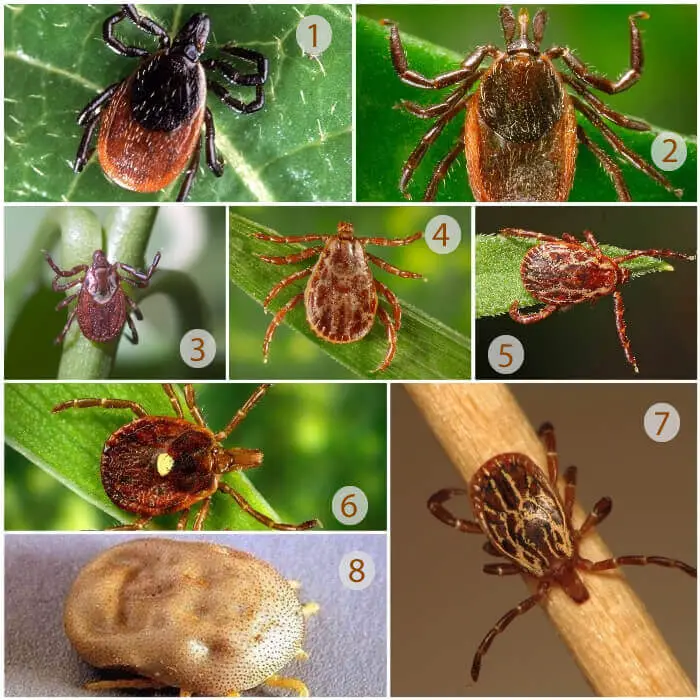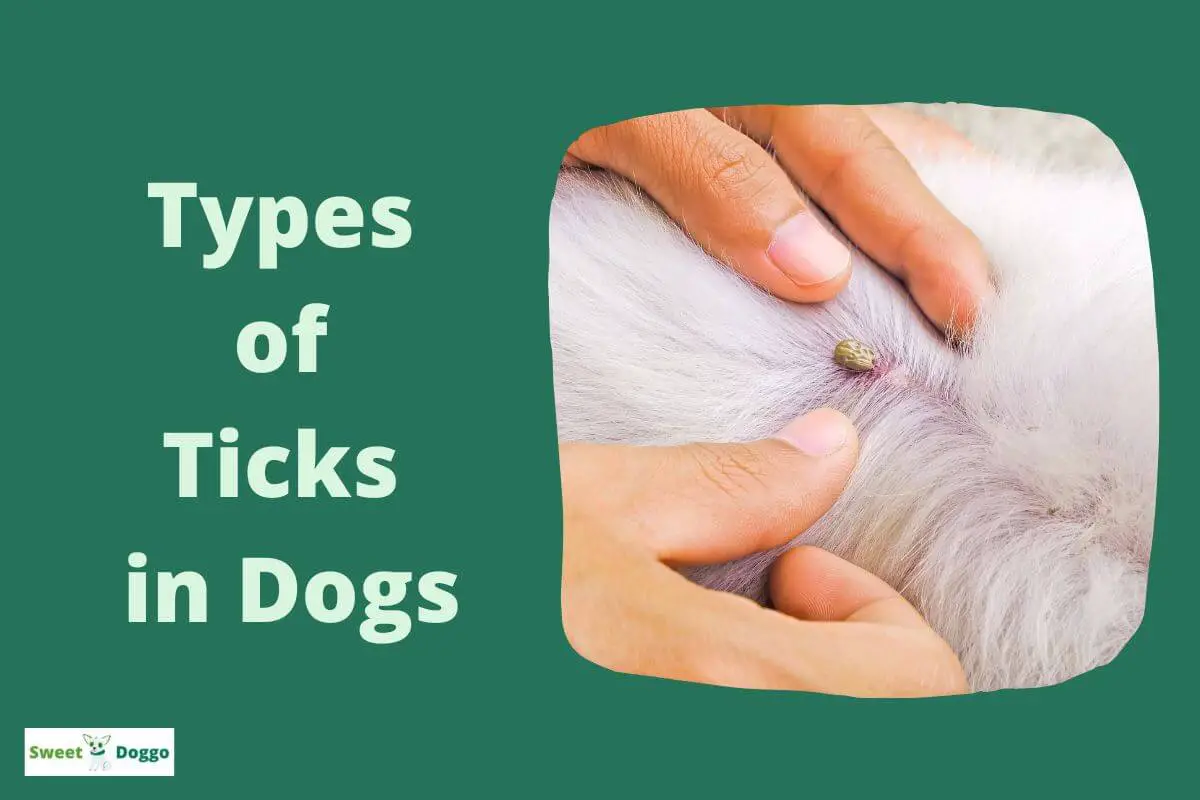We all know how annoying ticks can be to our pets. They feed voraciously on the blood of the host once they are attached to it. Did you know that not all ticks are the same?
This article explains the different types of ticks in dogs, how to identify them, what to do if you find several ticks, and why they are dangerous not only to your dog but to you as well.
Table of Contents
Ticks: what are they and how do they behave?
It is worth briefly describing the behavior and some interesting facts about these invasive creatures before discussing the types of ticks in dogs.
- The tick is not an insect, but an arachnid-like spider, scorpions, and mites. Ticks have 8 legs and no antennae.
- The tick is a parasite that feeds on the blood of its host. For a long time, they can go unnoticed.
- Depending on the species, blood-sucking behavior can vary.
- It is common for ticks to have a preferred feeding area on their hosts. While some prefer to feed near the ears, nostrils, anus, and under the tail, others prefer to feed near the head, neck, and pubic areas.
- Ticks can survive for months or even years without food, depending on the environmental conditions.
- Among the diseases they carry are canine ehrlichiosis, anaplasmosis, Lyme disease, and babesiosis.
There is a very common misconception among dog owners that ticks and fleas are the same things. Ticks are arachnids (8 legs), while fleas are insects (6 legs).
Types of ticks in dogs
There are two general types of ticks in dogs. These are:
- Hard ticks, Ixodidae
- Soft ticks, Argasidae
Hard ticks have a hard shield behind their heads, often covered in white or gold patterns on a brown or gray background. These ticks look like flat seeds when not fed.
As for “soft” ticks, they do not have one. Their bodies are flat, oval, leathery, and wrinkled as adults.
Difference between hard ticks and soft ticks
What type of tick does a dog have? What’s the difference? Hard ticks and soft ticks differ in more than just physical characteristics, so it’s important to know how to identify them.
Appearance
Hard ticks
- They are flat, oval, and have a hard “plate” on their back, which covers the entire dorsal surface of the male, but only a third of the dorsal surface of the female.
- Depending on the species they can measure between 3 and 23 mm in length. The female is usually larger than the male.
- The hard tick’s mouthparts are visible when viewed from above. This is a characteristic that helps to easily differentiate it from the soft type of tick.
Soft ticks
- They are oval or pear-shaped, with the anterior region of the body broadly rounded.
- They appear to have wrinkled bodies and lack the dorsal shield that characterizes hard ticks.
- Males and females are very similar in size.
- The mouthparts are located below the body and are not visible from above (it gives the impression that they do not have a mouth).
Feeding habits
Both types of ticks feed on the dog’s blood.
Hard ticks generally seek out their hosts and feed during the day. They tend to feed for long periods of time, from several days to weeks; this depends on factors such as species, life stage, and type of host.
For their part, soft ticks seek out their host and feed at night. Feeding periods are usually shorter, ranging from minutes to days. The feeding habits of many soft ticks can be compared to that of fleas or bedbugs, as once established they reside in the host’s nest and feed rapidly once the host returns.
Habitat
Hard ticks thrive in habitats where there are many vertebrate hosts, such as mammals, lizards, and ground-dwelling birds. Its preferred habitat is scrub, woodland, or undergrowth, especially moist woodland and vegetated areas (hiking trails, grassy fields, etc.).
Soft ticks inhabit animal burrows, nests, caves, or human construction such as cabins and sheds. These ticks easily thrive in hot, dry conditions.
Disease transmission
Compared to soft ticks, hard ticks are more likely to parasitize both animals and people. This is the type of tick that transmits the greatest number of diseases.
Hard ticks
- Lyme’s disease
- Rocky Mountain spotted fever
- Tularemia or rabbit fever
- Colorado tick fever
- Ehrlichiosis
- Babesiosis
- Tick bite paralysis
- Anaplasmosis canina
Soft ticks
- Tick-borne relapsing fever
8 Common ticks on dogs
According to different sources, these are the 8 most common tick species on dogs:
“hard” type
- Black-legged or deer tick (Ixodes scapulars)
- Western Black-legged Tick (Ixodes pacificus)
- American dog tick (Dermacentor variabilis)
- Rocky Mountain wood tick (Dermacentor Anderson)
- Brown dog tick (Rhipicephalus sanguineus)
- Lone star tick (Amblyomma americium)
- Gulf Coast tick (Amblyomma maculatum)
“soft” type
- Spiny ear tick (Otobius megnini)
Could you identify them? Take a look at the following image and discover what the ticks most likely to infect your dog look like …
The numbers in the image correspond to the numbers in the listing above.

Of all of them, these 5 are usually the best-known ticks around the world:
1. Brown dog tick
Typically brown, but may turn bluish-gray when fed; It is oval and flat in shape. Dogs are their favorite host. It almost always sticks to the ears or between the toes.
2. Lone star tick
It is reddish-brown in color but turns dark gray once it has eaten. It has an easily visible white spot on the back of its body.
3. American dog tick
It is flat, oval, and usually brown with gray or whitish markings.
4. Black-legged tick
It is oval, wide, and flat. Although it can be difficult to distinguish from the brown tick because of its reddish-brown body color, this species has significantly darker legs.
5. Rocky Mountain wood tick
Its body is flat and pear-shaped, reaching an approximate length of 3 to 16 mm. It is usually brown in color but turns gray when swollen.
FAQ’s
What is the life cycle of a tick like?
The life cycle of ticks is made up of 4 different stages or phases6:
- Egg
- 6-legged larva
- 8 legged nymph
- Adult
Initially, the adult female tick lays her eggs on the ground. A female can produce between 3,000 and 6,000 eggs. When the ambient temperature and humidity reach optimal levels, the eggs hatch, and the larvae emerge.
Tick larvae are usually very small. Birds and rats are their main hosts at this stage. Once they have fed on the blood of their host, the larvae increase in size. When they are fully fed and large enough, they leave the body of their first host.
At this point, the larva molts its shell and becomes a nymph. The nymphs repeat the same process by searching for and attaching themselves to a second host, which they will abandon once they have fed sufficiently. Following a second molting process, the nymph develops into an adult tick.
When two adult ticks mate, the female lays her eggs on the ground and begins a new life cycle.
How do dogs catch ticks?
Typically, ticks remain in grass or on the edges and tips of bushes, awaiting the arrival of potential hosts. When the dog passes and rubs the vegetation, the tick quickly detaches itself from the plant and climbs onto the host.
That said, if a dog spends a lot of time outdoors, especially in wilderness areas, they are at higher risk of picking up ticks. Direct contact with them almost always results in an infestation.
Ticks can only crawl; they cannot jump or fly. Even so, some species are known to be able to crawl several feet to reach their host.
How to detect ticks on a dog?
Unlike fleas, ticks are usually large enough to be distinguished on the dog’s body. This is especially true if they have already eaten.
Upon close inspection, you will be able to see them as if they were small warts. Be sure to check on the dog regularly, parting the fur a bit and running your fingers over its fur.
You can usually find them around the pet’s head and neck, but they can also stick to the paws and under the tail. Also consider that tick bites usually cause some signs on the dog’s body, such as irritation and redness.
Ticks that have been on a dog for only a short time (1 hour to 1 day) may appear flat. But those that have been feeding for days will look quite rounded.
How to remove ticks from dogs at home?
In most cases, it is not necessary to go to the vet to clean the dog of ticks. This is the basic procedure to remove them at home …
You will need to:
- 1 pair of gloves
- 1 pair of clean pointed tweezers
- An antiseptic, for example, hydrogen peroxide
Instructions:
- Using the tweezers, grab the tick as close to the dog’s skin as possible, without actually pinching it.
- Slowly pull outward in a steady motion, making sure to remove the entire tick. If the head remains attached to the dog’s body, it could lead to infection or inflammation. It is very important to pull steadily, but slowly.
- After the extraction, disinfect the area with an antiseptic; you can do it with hydrogen peroxide or soap and water.
- Never try to remove a tick with your bare hands. These parasites are successful transmitters of numerous diseases.
Note: If the tick is in an area that is difficult to access, you can resort to applying soapy water or apple cider vinegar to facilitate its removal.
To know all the steps, useful tips, and warnings, visit How to Remove Ticks in Dogs Fast? Easy Method + Remedies.
You may also be interested in 15+ Best Homemade Flea Remedies
How to prevent ticks on dogs?
Keep your dog away from tick-infested areas to prevent infection.
They tend to live in particular microhabitats, like grass or the boundary between lawns and wooded areas. Ticks are less likely to reach pets when these habitats are properly maintained.
Keep the dog out of tall grass and brush, and trim vegetation around the house. Also, insecticides may help.
You can also use anti-tick products, such as sprays and shampoos, to repel ticks and keep your dog’s coat clean.
Can ticks be dangerous for my dog?
On their own, ticks do not pose much of a threat to your pet’s health; however, these parasites are known to transmit numerous infectious conditions.
As they feed, ticks can introduce microorganisms into the body of their host. This includes the pathogens that cause Lyme disease, Rocky Mountain spotted fever, babesiosis, and ehrlichiosis, among others.
In addition, ticks release toxins that are harmful to their hosts. Cutaneous wounds caused by their bites can lead to secondary bacterial infections and infestations of other parasites.
Serious tick infections can lead to anemia, paralysis, and even death in the dog.




